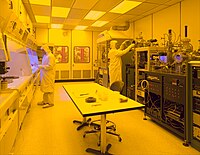
Photo from wikipedia
One of the unique characteristics of semiconductors is the strong dependence of their properties on crystal defects and doping. However, due to the species diversity and low density, it is… Click to show full abstract
One of the unique characteristics of semiconductors is the strong dependence of their properties on crystal defects and doping. However, due to the species diversity and low density, it is very difficult to control the type and concentration of the defects. In perovskite materials, crystal defects are randomly formed during the fast crystallization process, causing large heterogeneity of the samples. Here, in this work, we report a controllable method to introduce surface defects on CH3NH3PbI3 perovskite materials via the interaction with 1,4-benzoquinone (BQ) molecules on the gas and solid interface. After the adsorption of BQ molecules on the perovskite surface, surface defects can be generated by photoinduced chemical reactions. The concentration of the defects can thus be controlled by precisely regulating the laser irradiation time. The concentration of the defects can be characterized by a gradually decreased PL intensity and lifetime and was found to influence the atmospheric response and the subsequent acetone-induced degradation of the materials. These results demonstrate that crystal defects in perovskite materials can be controllably introduced, which provides a possible way to fully understand the correlation between the nature and chemical structure of these defects.
Journal Title: Nanomaterials
Year Published: 2022
Link to full text (if available)
Share on Social Media: Sign Up to like & get
recommendations!